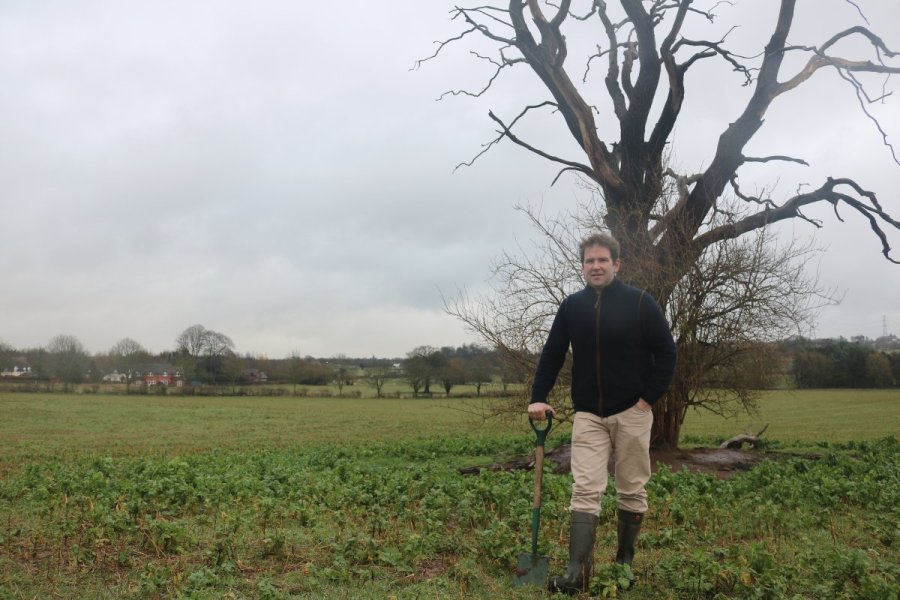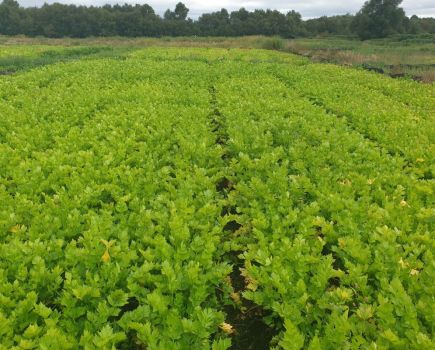A move to regenerative agriculture for a West Midlands grower has already improved soil and plant health and reduced reliance on synthetic inputs. CPM visits to find out how these values can now be traded on emerging markets.
We’re sequestering large amounts of carbon through the regenerative agriculture practices we follow. We want to take control of that.
By Tom Allen-Stevens
Michael Kavanagh scoops up some quinoa from the heap and inspects the sample cupped in his hands. “This is red quinoa, which has a richer taste and nuttier flavour compared with the more common white type,” he explains.
“It’s a tricky crop. You harvest it when it’s green and you can’t use glyphosate. In fact, there are very few chemicals you can use on it. But then that fits with our farming system. We’re losing chemicals hand over fist, and we want to make the most of farming without them,” he says.
He gestures to the cluster of IBCs over the other side of the shed. These are where he makes up his biological “brew” – a range of complementary bacteria are multiplied up with molasses and applied to the crop at every pass with the sprayer. “One 1000-litre IBC covers 40ha. You have to warm it up and bubble air through to encourage the bacteria, then it has to be applied within a day,” he continues.
“We still make as many passes through the crop as we used to, but I only apply one fungicide, no growth regulators, no insecticide. The timings are similar to the traditional T-timings, but focused more on crop need – I spend a lot more time walking and inspecting the crops than spraying them.”
Synthetic inputs are being replaced with biology, targeted nutrition and a close eye on judging what the crop requires at Church Farm, Boningale, near Wolverhampton. Michael is farm manager for the 245ha DGF & MAM Thompson Farms, with its 200ha of arable crops as well as a 400-ewe lambing flock of Lleyn and Abermax crosses.
He’s also one of the Green Farm Collective – six Soil Farmer of the Year finalists who have a desire to improve their farming system with a view to profit. The aim is to bring more like-minded farmers on board and trade the carbon they sequester through the emerging natural capital markets.
“Margins are being squeezed and with BPS disappearing we don’t want to sit back and wait for whatever scheme the Government has in mind. We’re all sequestering large amounts of carbon through the regenerative agriculture practices we follow. We want to take control of that – measure it along with the enhanced water quality and biodiversity co-benefits that accrue. We have customers keen to work with us and buy into the good work we’re doing.”
Michael arrived at the farm seven years ago, with a brief to maintain profitability without renting out land for root crops and vegetables, on which much of the farm’s income had previously relied. Milling wheat and oats are now rotated across the farm’s sandy loam soils with malting barley, oilseed rape, quinoa and grass leys.
“Drought is our biggest limitation, and keeps wheat yields pegged below 9t/ha in most years. Although last year we had a crop after quinoa that averaged 10t/ha, and that’s shown me our soils are capable of higher yields if we treat them right,” he maintains.
Previously they were routinely ploughed and power-harrowed, and he found soil organic matter (SOM) content was below 2.5%. “I knew regenerative agriculture was the route to revive them and enhance their potential, not that I’d heard of the term back then. Apparently for every 0.1% you raise SOM you increase water-holding capacity by around 16,800 l/ha.
“But what drove me down the no-till route was the need to reduce workload – how do I farm 200ha of arable with sheep on my own?”
Michael bought a 3m second-hand Claydon Hybrid drill to establish all the crops in one pass. “In the first couple of years we had to subsoil to remove plough pans, but the soil structure soon improved – we went from needing 200hp burning 13 l/ha of fuel to 150hp using 8 l/ha.”
Wondering if he could reduce tillage further, he noticed that where the sheer bolt on one of the Claydon’s leading tines had broken, effectively drilling direct, there was no difference in crop performance. So more recently the system has moved to a 4m John Deere 750A drill, lugged behind a JD 6130R – 130hp burning just 5 l/ha.
“It was not just the cost reduction – I could see the improvement in the soil, in worm numbers, in how it smells. In six years, we’ve raised the average SOM to 3.25%, and that includes two wet winters. It’s this improvement in soil health that really got my interest going in how plant health may be related,” says Michael.
Another stat he’s picked up is that is that 85-90% of plant nutrient acquisition is microbially mediated. “It makes you think – a plant can only take up the nutrients it needs if it’s sitting in soil with plenty of microbial activity, so we have to encourage those microbes. That starts with not killing them in the first place, and no tillage helps there. But I’m also looking to reduce fungicide and N applications and increase organic matter.”
High applications of synthetic nitrogen and potassium are believed to interfere with soil microbes, particularly those involved in cycling N. Michael has a straw-for-muck deal with a neighbour and mixes this with wood chippings to make a compost that feeds the soil with carbon, as well as N, P and K. This is spring applied by a contractor that can spread to 24m.
“It’s a balancing act, and through the season I keep close tabs on plant sugar levels with a Brix meter. You want enough N to optimise growth, but too much reduces Brix and that brings in pests and disease.”
So foliar feeds are applied with humic and fulvic acid to keep the crop in peak condition. He’s carried out tramline trials, applying half of the crop’s N through the soil and half through the leaf. Initial results suggest he can reduce foliar applications by as much 50% with no loss of yield. “Our average N applications to wheat have come down from 240kgN/ha to just 165kgN/ha and we haven’t needed any bagged phosphate or potash,” he reports.
Michael’s joined by Sarah Ferrie from Interagro, who have carried out crop trials for many years looking at how to stimulate plant growth, access available nutrients and mitigate against stress. “The whole ethos of biostimulant feeding is to create a more efficient plant, with higher energy levels – one that can focus on putting its own assimilates into the growing points, while helping the crop overcome stress more quickly. Biostimulants can rapidly help reset the balance between stress resistance and growth,” she notes.
“This can reduce the need for synthetic inputs – you can optimise what you put on without having to rely on them to give a plant resilience. It gets this from the soil’s own circular economy – using plant sugars exuded by roots to cycle nutrients released by soil organic matter.”
Michael admits he was dubious at first of the benefits of the biological additions he now uses to encourage this cycling. “I sent wheat ear samples in for fusarium tests to compare. Levels in the untreated grain were 17% but the treated sample was completely clear – that was a bit of a wake-up call.”
Choice of the crop itself also plays into this, with milling varieties forming the mainstay of the wheat crop. Until this year, KWS Zyatt had been the variety of choice. “Yellow rust is the one disease that evades me and we have to treat for. So this year we’re including it in a four-way blend with KWS Trinity, Crusoe and Nelson, a German E wheat that should also help protein levels,” he says. There’s also 5ha of a heritage variety he’s growing for a specific milling market.
The diversity within the cropping extends to OSR, in which berseem clover is used as a companion crop to maintain the soil’s mycorrhizal fungi content – OSR is believed to inhibit the growth of this important soil constituent, he notes. “This year, we’ve established some OSR following a grass ley and managed to keep the white clover as an understorey, which should further reduce the need for applied N.”
Cover crops are another essential part, grazed by the sheep, which complete the regen ag picture. A ten-species mix is put in front of spring crops, that form a third of the arable acreage, or as a catch crop before winter cereals if the window after combining allows.
Michael’s currently capturing all the constituent parts of his arable system into Sandy, the digital assistant from Trinity AgTech. This is claimed to accurately records the carbon he’s sequestering along with biodiversity indicators and measures of water stewardship. This will then be traded by GFC through Trinity Natural Capital Markets.
“We’ll only trade our excess carbon, but the biodiversity is the more exciting part of the market. I’m quite proud that we’ve never used an insecticide here, and we reap the benefits of balanced predator numbers alongside a thriving bird life. 89 skylarks have been caught and ringed in the last two years on 60ha that we’ve monitored,” he notes.
“We can prove we can produce good quality food alongside doing good for the planet – the tools we’re using record, verify and can even geotag specific elements of the system we’re selling. We already have market interest, and this will grow as we surround ourselves with like-minded farmers. And the more we do, the more we’ll learn how to make the system even better.”
What makes Michael Kavanagh a Climate Change Champion?
Innovative ideas
Michael has embraced regenerative agriculture practices, resulting in a climate-positive carbon balance and improving soil health. Through the Green Farm Collective, he plans to capitalise on his natural capital gains.
Productivity push
A concerted effort to rely less on synthetic inputs and build soil organic matter (SOM) has reduced fertiliser use by over 30% while yield potential of the sandy loam soils has improved.
Cultivation care
A move to strip tillage and more lately direct drilling has seen average SOM levels increase from below 2.5% to 3.25% in six years.
Bio-based boldness
Quinoa heritage milling wheat provide added value, low input crops, while the biodiversity and water stewardship gains are measured and can be traded, too.
Stimulate the crop to nurture itself
Helping farmers build stronger, healthier, more resilient crops through biostimulation, anti-stress and nutrient-use-efficiency is a key priority for Interagro, says Sarah Ferrie.
“With soaring fertiliser prices, climate change, and the need for renewable and sustainable inputs that promote regenerative farming practices, the plant health benefits of biostimulants offer growers a chemical-free alternative for growth enhancement, nutrient-use-efficiency, and stress mitigation.”
Replicated trials in the field and in controlled environment conditions have shown biostimulant Bridgeway adds significant rooting – lateral and root length density – helping crops scavenge water and nutrients from depth in prolonged dry spells. “Increasing nutrient uptake and energising crops through higher rates of photosynthesis provide additional nourishment for higher productivity, while the stress-busting benefits of amino acids provide support to the plant’s immune system for added abiotic and biotic stress protection,” adds Sarah.
In good conditions, Bridgeway reduces the amount of energy the plant channels into protein production. Under stress conditions, it enables the plant to conserve energy and avoids the waste of breaking down proteins to recycle amino acids for stress defence. “It’s all about powering the crop as efficiently as possible, while securing yield under difficult growing conditions.”
Sarah notes Michael’s carefully considered and innovative approach to nurturing his crops, free from synthetics and informed by regular monitoring. His focus on nourishing the crop, informed through testing and trialling, builds plant health and the soil biology that sustains it. “He’s achieved so much in terms of reducing his carbon footprint, boosting biodiversity and future-proofing his business from a sustainability and profitability point of view. It’s an inspirational approach that you can’t help but admire and champion,” she says.
Last chance to be a Climate Change Champion
If you’re doing your bit to champion the cause of the arable sector on its path to net zero, we’d like you to step forward.
CPM has teamed up with leading agricultural suppliers who have a credible Net Zero aspiration to identify individual growers, thought leaders who have already started on this journey. We want to bring them into the top-level discussion about how farming can position itself as the solution to climate change.
UK Farming has set itself the challenging target of Net Zero emissions by 2040. Although led by the NFU, it will take the entire industry, working together in a partnership approach to meet this ambitious goal.
But it will be the growers with the ideas, the progressive outlook and the determination to shape positive change who will make it happen. If that’s you, please apply to be one of our 2022 Climate change Champions today. The closing date is 31 March 2022.
CPM would like to thank our sponsors: BASF, BKT, Interagro, Lloyds Bank, Trinity AgTech




